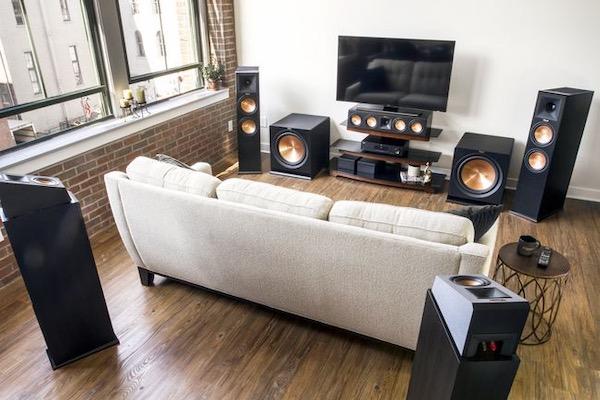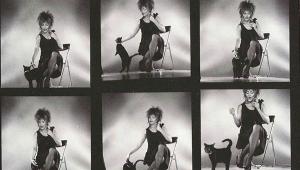Positioning Speakers for Best Performance

This discussion will apply primarily to the left and right front speakers since you need to get that pair correct before even thinking about the rest. Subwoofer placement is a study in itself and has been covered to death both on this site and elsewhere. I won't address it in any detail here. As for the center speaker, at least keep if off the floor. And need I say that the same applies to so-called "bookshelf" speakers, which will rarely perform their best if actually placed in a bookshelf?!
The Room
Your room will actually have more impact on the final result than the speakers themselves, no matter how carefully you set them up. Rooms should be neither overdamped nor excessively reflective, but the latter is the worst offender. If your room has bare floors, hard bare walls, and lots of uncovered windows (in other words, your "decorator" has a museum fetish!) it will be next to impossible to get even acceptable sound. The photo at the top is a prime example of ignored acoustic treatment. Poor dialogue intelligibility, for example, is often, at least in part, due to excessive room reflections. In this situation room equalization won't help. Ceilings are difficult to treat, but carpets or rugs (at least a large rug on the floor between the speakers and the listening position), will help, as will window drapes and the right choice of furniture. Genuine leather, unfortunately, is at least somewhat reflective, no matter its current popularity.
Don't wall me in
A reader recently commented on a review in which I described positioning the speakers 3-4 feet out from the wall behind them. He said that such placement was impractical for him. That's understandable, but the fact is that most loudspeakers are designed to work best when located at least somewhat clear from adjoining walls. Most serious audiophiles set up their speakers that way. It's also especially important if your speakers have rear bass ports, though this will be less significant if you're using a subwoofer and rolling off your main speakers below 80Hz or so. If you must place the speakers hard up against the back wall, experiment with moving them out a bit during critical listening. You can move them back when needed (though I wouldn't use spikes on them in this situation!). Room EQ can also help, but likely won't fully compensate for poor positioning.
Locating a speaker too close to a side wall can also degrade the result, but it's sometimes unavoidable. If your room is ten feet wide and you're using a projection screen it may be impossible to keep the speakers well clear of the side walls. Moving any speaker close to a wall will reinforce the bass. While this might appear to be a good thing, the reinforced bass due to wall proximity may skew its balance with the midrange and highs in ways the designer never intended. Acoustic panels of a practical thickness on the side walls can help in reducing wall reflections in the mids and highs but won't help much, if at all, in the deep bass. In that situation room EQ might be your only solution.
This wall placement issue doesn't apply to a subwoofer. Because the latter only operates below 80Hz or so it will often perform its best in a near-wall setup. Its independently adjustable level can then keep the overall sound in proper balance if you're rolling off the main speakers' response below that same frequency.
Coffee table blues
This one is fussy and might be difficult to accept. but that big coffee table between your speakers and your couch will reflect sound from the front speakers . Much like similar reflections from a bare floor it will be slightly delayed from the direct sound. The result shouldn't be dramatic, but the combination could be audible. Try moving the table out of the way to determine if you can hear any difference, particularly on dialogue. Need a better place to rest your weary feet? Try a softly upholstered ottoman.
Speaker placement and listening/viewing distance
If you're not using an acoustically transparent projection screen you'll likely want the left and right speakers to be as close as possible to the edges of the screen. If your 16:9 screen is 110-inches diagonal, that would put the screen width at 95.7 inches (for a 16:9 screen, the screen width is the diagonal times 0.87). Add another foot or so for a left and right clearance between the speaker cabinets and the screen, plus the distance from the left and right speaker's drivers to the edge of their cabinets, and you get a spacing between the left and right speakers at a bit over 9-feet. A suitable viewing distance for this would be 9-12 feet. Eight feet might be better if your display is a TV of any remotely affordable size rather than a projector. In that situation you could move the speakers closer together for better cohesion between the picture and the sound, but if they're too close the audio soundstage will be cramped.
There's no substitute here for experimentation, often resulting in unavoidable compromises. Also note that in this audio-centric discussion I haven't addressed the complex subject of viewing anglehow much of your front field of vision the image covers. For 10 feet from that 96-inch inch wide screen the viewing angle is 43.6 degrees. Individual preference pays a big part here. This setup describes my current situation, and while I would be happy with a somewhat narrower viewing angle, the 10-foot distance between the screen and the main listening seat (the screen can't be moved) offers the best sound in my room. (Google viewing angle and you'll find a number of viewing angle calculators; I use the one referenced in the Sound&Vision link.)
Toe-in
You'll often see on-line photos of audio setups where the left and right speakers are facing directly forward. This can work for a single listener in a center seat (the preferred audiophile position for solo listening!). But for a group spread out on a couch, or even further away, it isn't at all optimum. If you're off to the left side and directly in front of the left, forward-facing speaker the balance will be skewed. You may hear the dialogue reasonably well if a center speaker is engaged, but the right speaker won't be useful to you at all. Because of that, I've long used a toe-in toward the center for both my left and right speakers. Given reasonable dispersion characteristics of those speakers (a long and complex subject), this toe-in will offer a reasonable audio spread from an off-center seat. It won't be perfect (and will be similarly skewed at an off-center seat in a movie theater or at a live concert), but will be miles better than the straight ahead setup.





























































